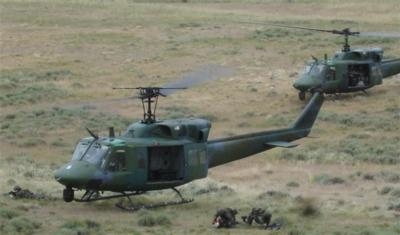Sun, Oct 26, 2014
UH-1N Iroquois Helicopters Are Aging And Past Intended Lifespan
Air Force Global Strike Command's Helicopter Operations Division hosted the Worldwide Helicopter Conference at Barksdale AFB in Louisiana Oct. 7-9, to discuss the current and future state of the Air Force's helicopter fleets.

The conference promoted cross talk among the Air Force's helicopter forces, which are principally operated by Air Combat Command, Pacific Air Forces, the Air Force District of Washington and AFGSC.
AFGSC, PACAF and AFDW operate a fleet of UH-1N Iroquois helicopters whose missions include surveillance of off-base nuclear weapons convoys, support of the Nuclear Security and Continuity of Operations/Continuity of Government missions and distinguished visitor airlift.
However, the UH-1N is an aging platform, operating well past its intended lifespan, said Col. Todd Worms, the AFGSC Helicopter Operations Division chief. To continue safe, secure and effective operations, a more capable platform is required.
ACC currently operates the HH-60G Pave Hawk to fulfill the Air Force's requirement to provide personnel recovery capability for its own forces as well as other Defense Department forces in hostile or isolated environments.
"We find that even though we're divided up into two operations, pretty much what affects one half affects the other; to include deployments, personnel shortfalls and maintenance issues," Worms said. "This is the one time each year we get to sit down and discuss all those issues with the commanders and the leadership from both sides to make sure we balance impacts across the force, come up with innovative ideas and exchange best practices. Budget restrictions resulted in the conference being cancelled in 2012 and 2013, making this year's information cross flow extremely beneficial."
Although the helicopter community is split across two platforms, the lessons learned from either side can greatly impact the future of the other.
"The Air Force's helicopter community is critical to a number of missions, and a common forum to address current and future issues is important to the Airmen who execute those missions," said Col. Charles Tomko, the ACC Personnel Recovery Division chief. "As we move forward with the Combat Rescue Helicopter Program, we will continue to work with our other helicopter partners to ensure we are all successful as a community to execute the missions the Air Force and combatant commanders task us with."
Worms also highlighted areas that a common rotary-wing platform across the Air Force would improve, including reduced training and maintenance costs, personnel efficiencies and common logistical practices across the force.
One particular area where commonality could be felt is in the helicopter training program.
The training that helicopter pilots go through currently requires aircrews to go through additional training when they transition between the UH-1 and the HH-60. A topic of discussion during the conference was how the Air Force can improve the process, avoiding the added cost of operating two separate platforms.
Currently, the goal is to have one rotary-wing platform for the Air Force. "If we buy the right things and make the right moves, we have an opportunity to build a much more capable and flexible helicopter force at a lower cost," Worms said.
ANN Salutes 1st Lt Christopher Mesnard, Air Force Global Strike Command Public Affairs.
(Image from file)
More News
Airbus Racer Demonstrator Makes Inaugural Flight Airbus Helicopters' ambitious Racer demonstrator has achieved its inaugural flight as part of the Clean Sky 2 initiative, a corners>[...]
A little Bit Quieter, Said Testers, But in the End it's Still a DA40 Diamond Aircraft recently completed a little pilot project with Lufthansa Aviation Training, putting a pair of >[...]
Line Up And Wait (LUAW) Used by ATC to inform a pilot to taxi onto the departure runway to line up and wait. It is not authorization for takeoff. It is used when takeoff clearance >[...]
Contributing To The Accident Was The Pilot’s Use Of Methamphetamine... Analysis: The pilot departed on a local flight to perform low-altitude maneuvers in a nearby desert val>[...]
From 2015 (YouTube Version): Overcoming Obstacles To Achieve Their Dreams… At EAA AirVenture 2015, FedEx arrived with one of their Airbus freight-hauling aircraft and placed>[...]
 Airbus Racer Helicopter Demonstrator First Flight Part of Clean Sky 2 Initiative
Airbus Racer Helicopter Demonstrator First Flight Part of Clean Sky 2 Initiative Diamond's Electric DA40 Finds Fans at Dübendorf
Diamond's Electric DA40 Finds Fans at Dübendorf ANN's Daily Aero-Term (04.23.24): Line Up And Wait (LUAW)
ANN's Daily Aero-Term (04.23.24): Line Up And Wait (LUAW) NTSB Final Report: Extra Flugzeugbau GMBH EA300/L
NTSB Final Report: Extra Flugzeugbau GMBH EA300/L Classic Aero-TV: 'Never Give Up' - Advice From Two of FedEx's Female Captains
Classic Aero-TV: 'Never Give Up' - Advice From Two of FedEx's Female Captains



